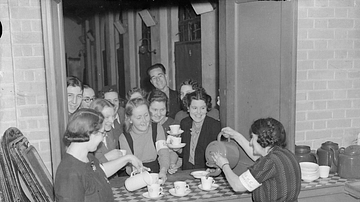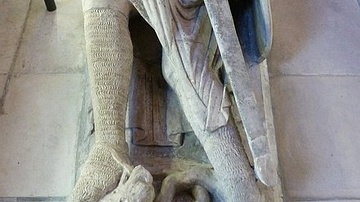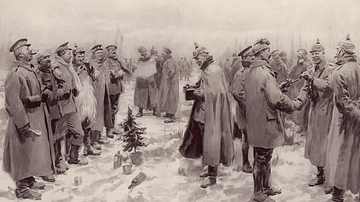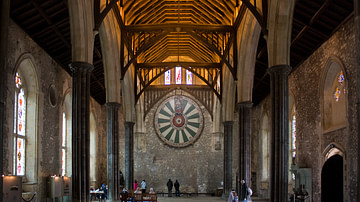Search
Search Results

Image
Firefighters, London Blitz
A photograph of firemen fighting a blaze during the London Blitz (1940-1). St. Paul's Cathedral can be seen in the background. (Imperial War Museums)

Image
Volunteers Distributing Tea during the London Blitz
A photograph showing tea being distributed by volunteers to air raid shelters during the London Blitz of 1940-1. John Keble Church kitchen. (Imperial War Museums)

Image
Effigy of Gilbert Marshal at Temple Church, London
This effigy of Gilbert Marshal (1194-1241 CE) is one of the best-preserved effigies at Temple Church, London. Air raids during the Second World War severely damaged others.

Image
Christmas Truce, Illustrated London News
An illustration of the Christmas Truce of 1914 on the Western Front during the First World War (1914-18). This first appeared in the London Illustrated News and was drawn by Arthur Cadwgan Michael.

Video
Prometheus the Greek Titan of Forethought who Gave Fire to Humanity
Prometheus is the titan god of forethought, is something of a trickster in Greek mythology, and is best known for his role in stealing fire and giving it to humanity, only to be punished severely by Zeus, the king of the gods. Despite being...

Definition
Great Hall
The Great Hall was the architectural centrepiece of a medieval castle's interior and functioned as the social and administrative hub of the castle and its estates. With everyone dining and sleeping in the hall in its early days, the room...

Definition
Great Exhibition
The 1851 Great Exhibition was held in the purpose-built Crystal Palace in Hyde Park, London, to showcase the latest developments in engineering, science, and the arts, as well as objects of cultural significance from Britain and abroad. Running...

Video
Agni - The God Of Fire
Agni is an acceptor of sacrifices and the God of Fire. He is ever young because the fire is re-lit everyday. He is depicted with two heads, one that symbolizes immortality and the other marks an unknown symbol of life. Watch the video to...

Article
Alexander the Great & the Burning of Persepolis
In the year 330 BCE Alexander the Great (l. 356-323 BCE) conquered the Achaemenid Persian Empire following his victory over the Persian Emperor Darius III (r. 336-330 BCE) at the Battle of Gaugamela in 331 BCE. After Darius III's defeat...

Video
Hephaestus the Greek God of Fire and Metallurgy
Hephaestus is the Olympian god of metallurgy, smiths, craftsmen, and fire and is the blacksmith for the Olympian gods. In fact, many of the myths associated with Hephaestus have him crafting something, whether it be for his own use, or because...